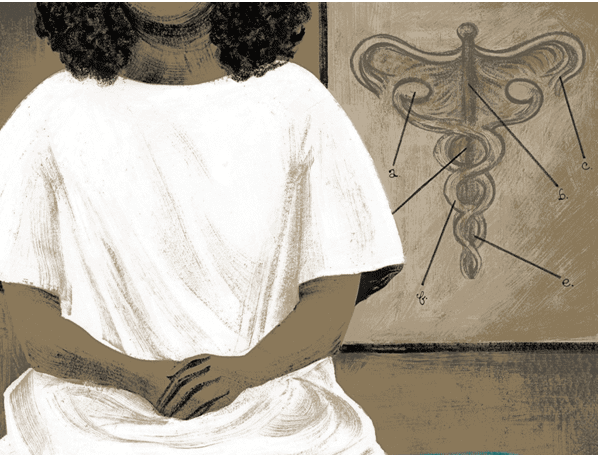The state’s refusal to expand Medicaid is causing poor women to miss out on lifesaving screenings.
By Eyal Press
One winter day in 2016, Tonya Carter felt a sharp pain in her lower back. In the months that followed, the pain grew more frequent and more diffuse, running down the back of her legs when she was sitting, and flaring up when she lay on the sofa in her living room at night. A devout Christian, Carter prayed that God, whom she referred to as “my ultimate physician,” would make the pain go away. It didn’t go away. She would have gone to see an actual doctor, she told me recently, but it was beyond her financial means.
Carter worked for Comfort Keepers, a company that provides in-home care for seniors. She liked the job, which involved tending to elderly people who required assistance with personal care and such chores as cooking and cleaning. Carter was a dedicated caretaker, sometimes fixing homemade corn bread and turnip greens for her clients. Her salary was low: eight dollars an hour, without benefits. “That’s good for around here,” said Carter, who lives in Anniston, a small city in northeastern Alabama with a troubled racial history—in 1961, a Freedom Riders bus was firebombed by a local mob—and an uncertain future. In 1999, a nearby U.S. Army base, Fort McClellan, closed down. Since then, Anniston’s population has shrunk, and the poverty rate has risen to nearly thirty per cent. Carter sometimes considered moving elsewhere, but her options were limited. At the time she started working at Comfort Keepers, she was divorced and had four children, three of whom still lived at home. Between rent, utilities, and providing for her family’s needs, her income was stretched far too thin to pay for health insurance.
In dozens of states, Carter would have qualified for Medicaid, particularly after the passage of the 2010 Affordable Care Act, which extended Medicaid benefits to all households earning up to a hundred and thirty-eight per cent of the poverty line. But in 2014, when Medicaid expansion took hold, Alabama and twenty-four other states, almost all of which had Republican-led legislatures, opted out; that year, Robert Bentley, then the state’s governor, argued that it would burden taxpayers and foster “dependency on government.” In Alabama, as in much of the South, the Affordable Care Act was derisively called Obamacare, and was attacked as a wasteful government program that showered benefits on undeserving recipients. In 2016, Donald Trump tweeted that Hillary Clinton “wants Obamacare for illegal immigrants.” More recently, Jeff Sessions, who is running for his former Alabama Senate seat, aired a campaign ad accusing Democrats of plotting to provide “free health care for illegal immigrants.” In fact, undocumented immigrants are ineligible for Medicaid, but it’s not hard to imagine how such a claim might arouse indignation among poor voters in Alabama, where the income requirements for Medicaid are more stringent than in any state except Texas. In a family of four, a parent qualifies for benefits only if the household income is less than three hundred and ninety-three dollars a month—roughly eighteen per cent of the poverty line.
Carter had gone years without a routine checkup; she hadn’t seen a gynecologist in more than a decade. As the months passed, her mind raced with theories about what might be wrong. Maybe she had kidney stones, or endometriosis. The pain spread through her abdomen and her pelvic area, and she began to bleed after intercourse. “It was just out of nowhere, and it was continuous,” she said.
At work, Carter ducked into the bathroom whenever the pain grew unbearable, hoping that her absence wouldn’t be noticed. After one such episode, she emerged to discover that her client, an elderly man, had walked outside and fallen. Although the man was not seriously injured, she was mortified by the incident.
By the summer, Carter was suffering so acutely that she finally sought medical care. The cause of her distress, she learned, was cervical cancer. Recently, a nurse informed her that the disease had advanced to Stage IV B: it had spread to her ovaries and other internal organs, and was considered terminal. Under Alabama law, now that she was sick, she qualified for Medicaid.
Acentury ago, cervical cancer was the deadliest form of cancer among women in the United States. Since then, the prevalence and the lethality of the disease have declined dramatically. The widespread use of Pap smears has allowed doctors to detect abnormalities earlier. And in 2006 the F.D.A. approved the use of the human papillomavirus, or H.P.V., vaccine, which can protect women from the most dangerous strains of the virus. Cervical cancer typically results from H.P.V. infections that are transmitted sexually.
Cervical cancer is now viewed by most physicians as preventable, and in more affluent parts of the country it is correspondingly rare. But in the poorer pockets of less wealthy states it remains disturbingly common. According to the American Cancer Society, more than four thousand women in this country will die from the disease this year. Women who develop cervical cancer in Alabama are more likely to die than their counterparts in any other state—and in recent years Alabama’s mortality rate has been rising.
“He can’t play this game, because I’m playing Only Child.”
In 2018, Human Rights Watch published a report identifying some of the reasons for Alabama’s outlier status. Sex education is not mandated in the public schools, which may help to explain why the state ranks low in H.P.V.-vaccination rates. In small towns and rural areas, the number of doctors and medical facilities has fallen, contributing to the proliferation of a disease that disproportionately affects poor women and women of color. The Human Rights Watch report found that Alabama women without medical insurance routinely delayed getting care, “which, for some, meant that gynecological cancers weren’t found until symptoms developed to more advanced stages.”
The Alabama Department of Public Health does operate a few programs that encourage prevention, including one that provides free screening for cervical cancer. But, because the program has a small budget and little funding for outreach, many poor women are unaware that it exists. Human Rights Watch found that only eighteen per cent of eligible women were using the program.
Tonya Carter, overwhelmed by pain, eventually visited a clinic in downtown Anniston which caters to low-income people. She was discharged without receiving any diagnostic tests. “They didn’t even check my vitals,” she told me. The doctor, who criticized her for not having a gynecologist, said, almost in passing, “Why haven’t you contacted the health department?” She said nothing about free screenings. After visiting the clinic, Carter called her county health department, and learned of the state’s screening program. By the time she got a test, the cancer had spread.
I met Carter on a damp, overcast morning in December, a few weeks after she received the diagnosis of Stage IV B cancer. She had invited me to accompany her to a CT scan at an outpatient clinic. She is forty-eight, with pale-blue eyes and a diffident manner. Her scalp was bare, from multiple rounds of chemotherapy, and her short-term memory was spotty—“chemo brain,” she called it. The drugs had made her so fatigued that it was hard for her to get out of bed in the morning.
Nevertheless, Carter had forced herself to wake up early that day; like all her cancer-related medical appointments, the CT scan took place sixty miles west of Anniston, at a clinic near Birmingham. Since 2010, fourteen hospitals in the state, more than half of them in rural areas, have closed, forcing women to make long treks to get care. Corporate consolidation and low reimbursement rates from the federal government have contributed to the trend, but another major factor is Alabama’s refusal to expand Medicaid. For years, the emergency rooms of rural hospitals have been inundated with poor, uninsured patients. Hospitals often receive no compensation for treating these patients, which lowers their operating margins and fuels what the Chartis Center for Rural Health has called a “closure crisis.” In February, the organization reported that the eight states with the highest number of rural hospital closures since 2010 had all declined to expand Medicaid.


